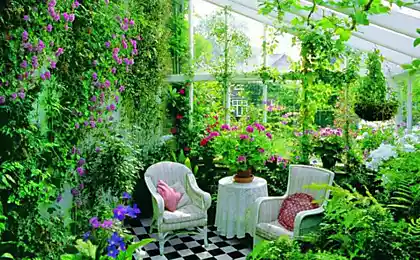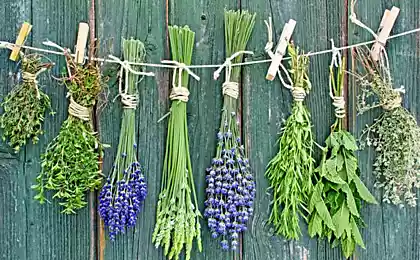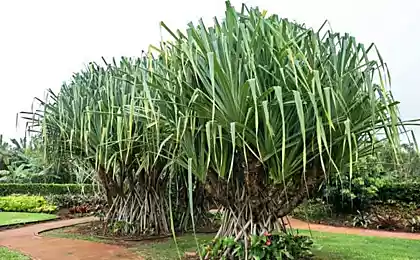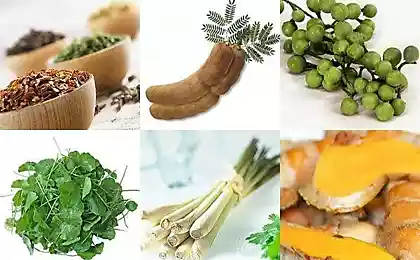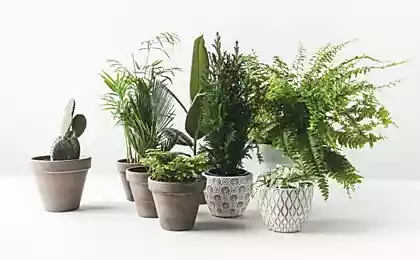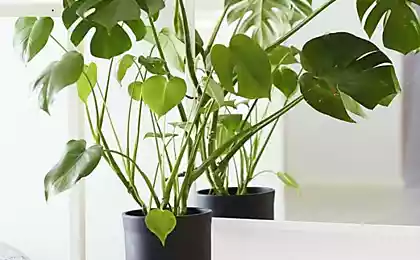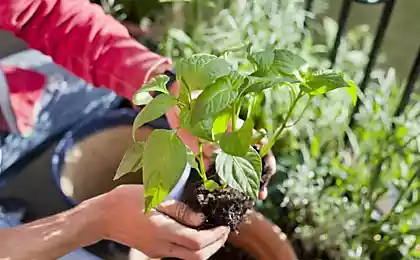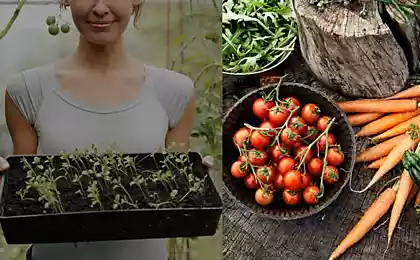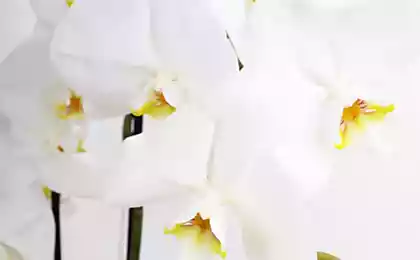634
10 most unusual houseplants
If the words "indoor plants" You come to mind only the ficus and geranium, then You have not read about the most unusual houseplants. Below — about the cultivation of flowers, which is rare to find in our apartments. These beauties will surely surprise and intrigue Your guests. And grow them, in fact, not so difficult.
1. Blue tillandsia (Tillandsia Cyanea)
It is a tropical guest of the bromeliad family. Very original spicate inflorescence: one appearance eliminates the extra frills, and in the fall on the side edges of the violet blossoms appear delicate lilac-purple flowers. Grows very slowly. Growth temperature: in winter 18 °C, at the same time to 25 °C. Light partial shade, moderate watering and periodic spraying. Humidity should be maintained continuously, is one of the basic conditions for growing. With this task easily cope humidifier.
When landing you need good drainage, and mix for planting must include peat moss shredded bark, and leaf soil with charcoal. On other planting mixes may be difficult to grow or not to grow at all.
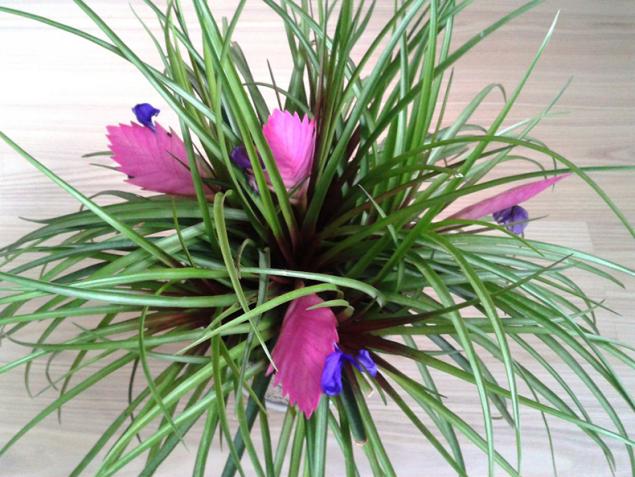
2. Tirucalli, Euphorbia, or Euphorbia elastica
This tree-like plant of the family Euphorbiaceae. Evergreen succulent plant with oddly twisted bare branches, flowers small greenish-yellow flowers. Like all spurges, is the holder of poisonous juice that can cause minor burns or an allergic reaction.

To purchase a planting mix for cacti and succulents. Pot should not be large, otherwise the plant will grow poorly. By the way, this milkweed grows to 1 m and growing strongly. Water moderately, spraying is not necessary. Select a bright, but light shade will also work. In the sun the stems are a little yellow, in shade more vibrant green. In the winter require a period of rest (usually after flowering). In this period the temperature must be 12-15 °C. in Summer you can make in light partial shade outside.
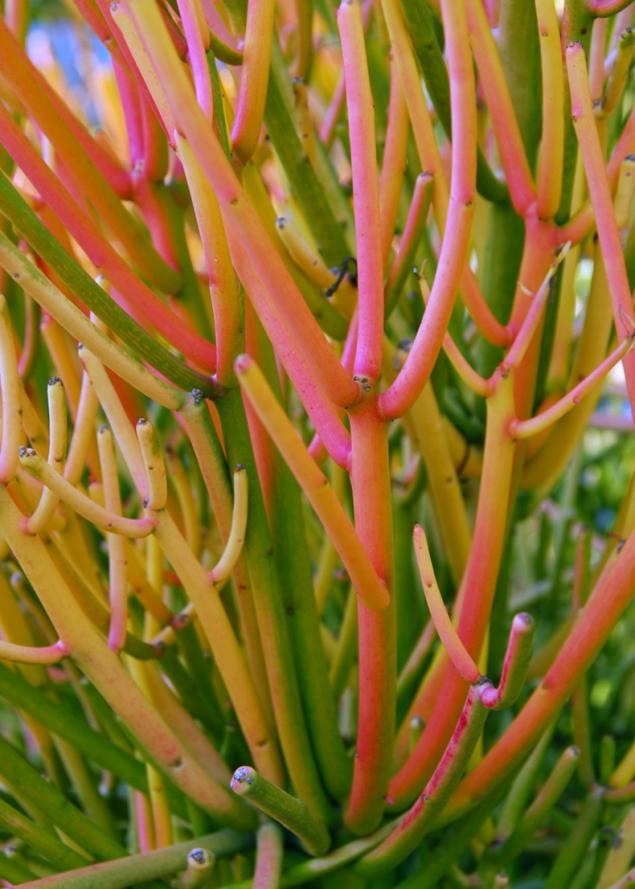
3. Hypocyrta naked (Hypocyrta Glabra)
Plant epiphytic basket, member of the family gesneriaceae. On bare stems, are small deep-green glossy leaves are elliptical in shape. Blooms from spring to late autumn bright orange flowers of unusual shape, which you can see in the photo below. Dry air and temperature changes when growing unacceptable. At low temperatures plant growth is slowed down.
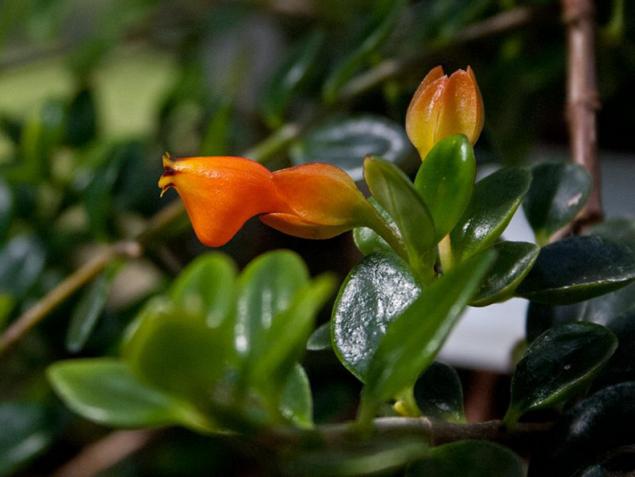
Air plant likes moist, soil for plants, too, should be moist, but not waterlogged stands, moreover, in winter reduce watering. Loves a Sunny place, preferably in direct sunlight during the day. The room temperature should be moderate, but winter likes a lower — 12-15 °C.
4. Lachenalia alumina (Lachenalia aloides)
Will give its owner elegant flowering in the middle of winter — high multi-colored stems appear clusters of elongated flowers-tubes yellow color with greenish, reddish, pink or purple hues. After Bud, requires rest. This should reduce watering 2-3 weeks after flowering, and then they stop. In September, the bulbs should be transplanted to a new land (the tip of the bulb to be placed below the level of the soil) and watered once, when shoots appear, you can continue watering. The plant likes moisture, so it sometimes need to be sprayed. Lachenalia prefers sun, especially on the windowsills, where a half-day direct sunlight, but the heating does not accept. Grows well and blooms at temperatures 7-15 °C. Enclosed balcony plus low temperatures in winter going for it at the time. Plant height 35-45 cm
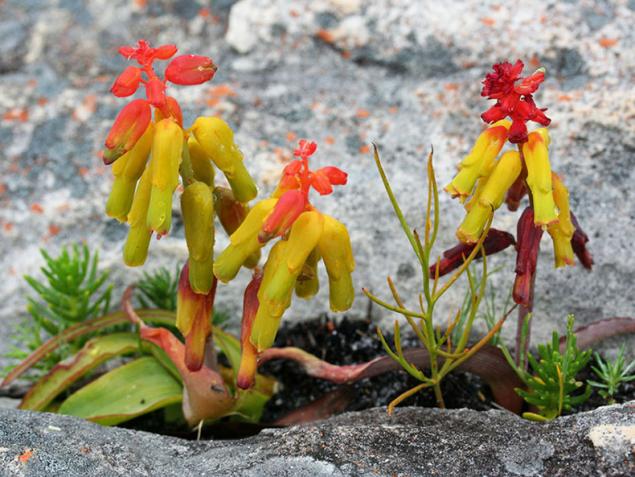
5. Calathea wonderful (Calatea Insignis)
Valued for its ornamental leaves, they can be from white to deep-green color with unusual stains and patterns, and kalateya saffron is grown more for the beauty of flowers. The plant likes the care and constant care. It needs to be protected from drafts, direct sunlight (light partial shade or diffused light), placed in a warm room in winter and to organize high humidity( constant watering until the winter, in the winter to reduce). Transplant should be 1 every 2 years, division of the plant.
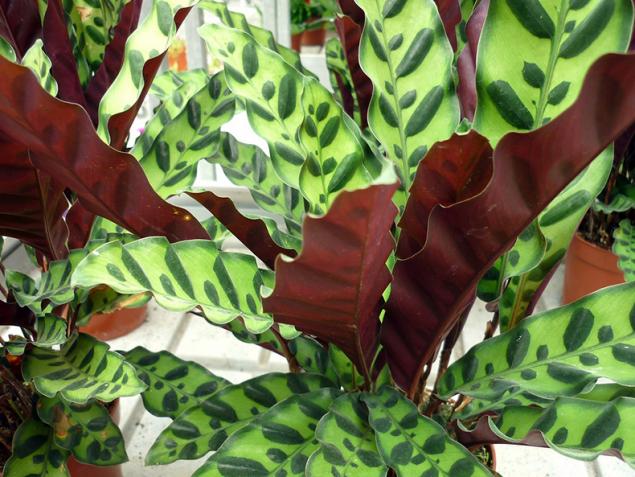
The most popular shapes:
6. Kohler positively (Kohleria eriantha)
She was extremely popular, now its not often seen and it is absolutely vain! This plant became popular as a basket, so it's best to select a planter or pot on a stand, but with the expectation for a long time. After planting the ground with the leaves is extremely difficult washed away, leaving dark stains. Bush plants are quite compact, juicy beautiful leaves with pubescence and bright colors with spots (red, orange, pink).
Kohler has straight, not branching shoots. In the indoor variant, the plant represented hybrid forms. Bloom can be up to 2 months, soft, fluffy patterned flowers. Belongs to the family gesneriaceae, require a rest in winter, so the upper stems are cut off and the nodules are given time to gain strength and to grow at temperatures above 14 °C, but not below 12 °C. in the Spring of each nodule it is possible to plant. Likes filtered light and more humidity, but should be sprayed around the plants, otherwise the leaves will appear spots, like burns. For the same reason, avoid direct sunlight.
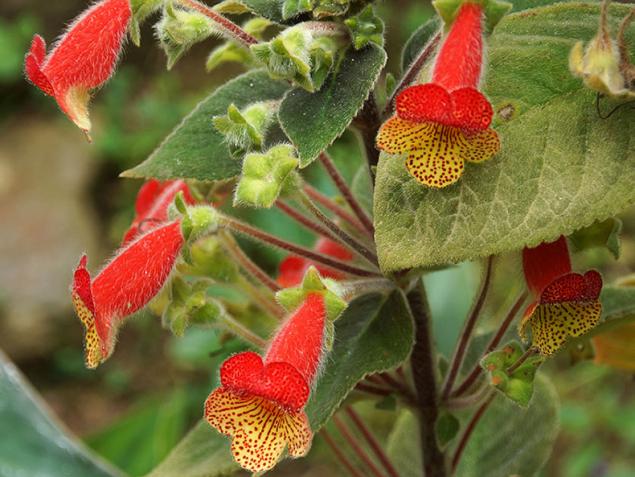
7. Small-leaved columnea (Сolumnea microphylla)
Gustooblistvennye basket plant with drooping, long, sometimes curly shoots. Stems brittle, with a length of 1.5 m. in Winter, reduce watering. Likes humidity, but spray around the plants, not to hurt the leaves. The flowers are bright, "big-eared". Loves the warmth and filtered sunlight.

8. Variegated stapelia (Stapelia Variegata)
Is a small succulent with spotted or striped unusual flower smelling of rotten meat that attracts flies for pollination. The plant does not tolerate transplanting, if the roots are damaged, immediately say goodbye to him. Otherwise very undemanding. Temperature for development may be 12-14 °C. Photophilous, spraying is not needed.

9. Vriesea
Has some striking species with large, bright racemes. Can be transplanted with roots and suckers in a couple of months. To transplant is when the pot became too small for the plant. When flowering ends, be sure to remove parent socket to give the plant a chance to recover and form a new outlet. The room develops at normal room temperature, but in the winter does not like dropping below 15°C. Place the flower choose bright but with scattered sunlight.The soil of the plant should be wet in the middle of the rosette of leaves should always be water. Every few months water need to upgrade.

10. Venus flytrap (Dionaea muscipula)
The flower is popularly called "the mousetrap dione". The teeth of the inflorescence about 15 cm Transplanting is not required.Sometimes you can spray the leaves, and in a period of growth needs good soil moisture, watering profusely. Pot is better positioned on the tray of rainwater or melt water. Grows well in full sun with light shading from the midday sun. Normal room temperature in winter not below 15 °C. the Plant is sometimes fed with dead flies, then plant some time digesting food with the petals closed doors, she can also attract flies, smell, and then absorbs them.
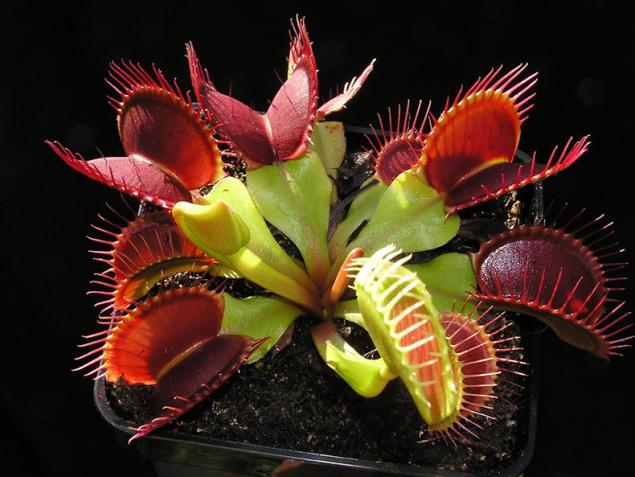
Here is a list of unusual houseplants happened. You might have to get one (or several), and perhaps some of these plants already in your lives? published
P. S. And remember, only by changing their consumption — together we change the world! ©
Join us in Facebook , Vkontakte, Odnoklassniki
Source: www.7dach.ru/SilVA/10-samyh-neobychnyh-komnatnyh-rasteniy-4415.html
1. Blue tillandsia (Tillandsia Cyanea)
It is a tropical guest of the bromeliad family. Very original spicate inflorescence: one appearance eliminates the extra frills, and in the fall on the side edges of the violet blossoms appear delicate lilac-purple flowers. Grows very slowly. Growth temperature: in winter 18 °C, at the same time to 25 °C. Light partial shade, moderate watering and periodic spraying. Humidity should be maintained continuously, is one of the basic conditions for growing. With this task easily cope humidifier.
When landing you need good drainage, and mix for planting must include peat moss shredded bark, and leaf soil with charcoal. On other planting mixes may be difficult to grow or not to grow at all.

2. Tirucalli, Euphorbia, or Euphorbia elastica
This tree-like plant of the family Euphorbiaceae. Evergreen succulent plant with oddly twisted bare branches, flowers small greenish-yellow flowers. Like all spurges, is the holder of poisonous juice that can cause minor burns or an allergic reaction.

To purchase a planting mix for cacti and succulents. Pot should not be large, otherwise the plant will grow poorly. By the way, this milkweed grows to 1 m and growing strongly. Water moderately, spraying is not necessary. Select a bright, but light shade will also work. In the sun the stems are a little yellow, in shade more vibrant green. In the winter require a period of rest (usually after flowering). In this period the temperature must be 12-15 °C. in Summer you can make in light partial shade outside.

3. Hypocyrta naked (Hypocyrta Glabra)
Plant epiphytic basket, member of the family gesneriaceae. On bare stems, are small deep-green glossy leaves are elliptical in shape. Blooms from spring to late autumn bright orange flowers of unusual shape, which you can see in the photo below. Dry air and temperature changes when growing unacceptable. At low temperatures plant growth is slowed down.

Air plant likes moist, soil for plants, too, should be moist, but not waterlogged stands, moreover, in winter reduce watering. Loves a Sunny place, preferably in direct sunlight during the day. The room temperature should be moderate, but winter likes a lower — 12-15 °C.
4. Lachenalia alumina (Lachenalia aloides)
Will give its owner elegant flowering in the middle of winter — high multi-colored stems appear clusters of elongated flowers-tubes yellow color with greenish, reddish, pink or purple hues. After Bud, requires rest. This should reduce watering 2-3 weeks after flowering, and then they stop. In September, the bulbs should be transplanted to a new land (the tip of the bulb to be placed below the level of the soil) and watered once, when shoots appear, you can continue watering. The plant likes moisture, so it sometimes need to be sprayed. Lachenalia prefers sun, especially on the windowsills, where a half-day direct sunlight, but the heating does not accept. Grows well and blooms at temperatures 7-15 °C. Enclosed balcony plus low temperatures in winter going for it at the time. Plant height 35-45 cm

5. Calathea wonderful (Calatea Insignis)
Valued for its ornamental leaves, they can be from white to deep-green color with unusual stains and patterns, and kalateya saffron is grown more for the beauty of flowers. The plant likes the care and constant care. It needs to be protected from drafts, direct sunlight (light partial shade or diffused light), placed in a warm room in winter and to organize high humidity( constant watering until the winter, in the winter to reduce). Transplant should be 1 every 2 years, division of the plant.

The most popular shapes:
- Kalateya Mako — broad leaves resemble paper texture. On top of the leaf pattern on the reverse side of a sheet of purple.
- Calathea decorated on the top with pink stripes leaves gradually turn pale, the inner side of the leaf purple.
- Calathea is wonderful — a large lanceolate leaf, about 45 cm with oval patterns.
- Kalateya striped leaves with a length of about 30 cm of dark color stains.
- Calathea pink-colorized (Calathea roseopicta) — oval leaves with Central pink stripe.
- Calathea the Lubbers — rich green oval leaves with bright green and yellow spots
- Kalateya saffron — flowers of this species for a long time pleasing to the eye, they are located on straight stems. Wrapped in luscious dark green leaves. The inner side of the sheet of greenish-purple hue.
6. Kohler positively (Kohleria eriantha)
She was extremely popular, now its not often seen and it is absolutely vain! This plant became popular as a basket, so it's best to select a planter or pot on a stand, but with the expectation for a long time. After planting the ground with the leaves is extremely difficult washed away, leaving dark stains. Bush plants are quite compact, juicy beautiful leaves with pubescence and bright colors with spots (red, orange, pink).
Kohler has straight, not branching shoots. In the indoor variant, the plant represented hybrid forms. Bloom can be up to 2 months, soft, fluffy patterned flowers. Belongs to the family gesneriaceae, require a rest in winter, so the upper stems are cut off and the nodules are given time to gain strength and to grow at temperatures above 14 °C, but not below 12 °C. in the Spring of each nodule it is possible to plant. Likes filtered light and more humidity, but should be sprayed around the plants, otherwise the leaves will appear spots, like burns. For the same reason, avoid direct sunlight.

7. Small-leaved columnea (Сolumnea microphylla)
Gustooblistvennye basket plant with drooping, long, sometimes curly shoots. Stems brittle, with a length of 1.5 m. in Winter, reduce watering. Likes humidity, but spray around the plants, not to hurt the leaves. The flowers are bright, "big-eared". Loves the warmth and filtered sunlight.

8. Variegated stapelia (Stapelia Variegata)
Is a small succulent with spotted or striped unusual flower smelling of rotten meat that attracts flies for pollination. The plant does not tolerate transplanting, if the roots are damaged, immediately say goodbye to him. Otherwise very undemanding. Temperature for development may be 12-14 °C. Photophilous, spraying is not needed.

9. Vriesea
Has some striking species with large, bright racemes. Can be transplanted with roots and suckers in a couple of months. To transplant is when the pot became too small for the plant. When flowering ends, be sure to remove parent socket to give the plant a chance to recover and form a new outlet. The room develops at normal room temperature, but in the winter does not like dropping below 15°C. Place the flower choose bright but with scattered sunlight.The soil of the plant should be wet in the middle of the rosette of leaves should always be water. Every few months water need to upgrade.

10. Venus flytrap (Dionaea muscipula)
The flower is popularly called "the mousetrap dione". The teeth of the inflorescence about 15 cm Transplanting is not required.Sometimes you can spray the leaves, and in a period of growth needs good soil moisture, watering profusely. Pot is better positioned on the tray of rainwater or melt water. Grows well in full sun with light shading from the midday sun. Normal room temperature in winter not below 15 °C. the Plant is sometimes fed with dead flies, then plant some time digesting food with the petals closed doors, she can also attract flies, smell, and then absorbs them.

Here is a list of unusual houseplants happened. You might have to get one (or several), and perhaps some of these plants already in your lives? published
P. S. And remember, only by changing their consumption — together we change the world! ©
Join us in Facebook , Vkontakte, Odnoklassniki
Source: www.7dach.ru/SilVA/10-samyh-neobychnyh-komnatnyh-rasteniy-4415.html
Without the sucker and life is bad: how to "throw" a tourist in different countries
Top 10 Eco-Films (Video)





